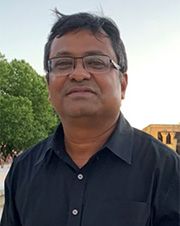New Frontiers in Full Wave-field Inversion: Journey towards Elastic FWI and direct Use of Raw Seismic Data
OR
Format: Virtual Webinar. 45 min. presentation followed by 15 min. Q&A
An optional post-lecture workshop will immediately follow each lecture for expanded Q&A and networking
Session 1, Tuesday, May 16, 2023, 11:30 am to 12:30 pm Beijing Time
Session 2, Thursday, June 15, 2023, 10 am to 11 am US Central Time
SEG Members Free Access Details
Two live sessions are completed. Please scroll down to watch the videos from the recordings below. SEG members, view the course for free!
Abstract
In this talk we strive to move closer to the vision of extracting full value from seismic data proposed by Tarantola in 1986 where the goal is inferring elastic properties of the subsurface via full physics driven solution - elastic full-wavefield inversion (eFWI). Over the past two decades, tremendous progress has been made in FWI and its application to many datasets from various geological basins in the world. The progress has mostly focused on acoustic FWI to determine high resolution velocity models of the subsurface to improve imaging either via ray based and/or wave-based imaging algorithms. In geologically complex areas, FWI can capture velocity variations at a scale useful for both imaging and acoustic property inversion, beyond what can be obtained with conventional methods. In a strongly elastic medium, acoustic physics can fall short in explaining the data and introduce errors in the results that can be difficult to quantify. Therefore, to fully explain the amplitudes of seismic data from near to far offsets elastic physics is necessary. The cost of solving eFWI is much more compared to acoustic FWI and for a 3D field scale application it would be not possible without significant advancements and investment in computer hardware and algorithms.
Elastic property inversion typically relies on post-migrated gathers or angle stacks to infer AVO (amplitude versus offset) information. Bandlimited P-impedance (Ip), Vp/Vs are routinely inverted from angle gathers with an estimated wavelet derived from available well. Data required for such inversions depend on several processing steps to preserve primary only reflection. These processing steps enable convolution physics to be applied in a local window where the wavelet is stationary. If processing can mitigate non-primary noise, and elastic contrasts are weak, convolution approach works well. In complex geological setting, such as hard/strong contrasts such as presence of sharp geological boundaries, the presence of non-primary reflection modes in the data (e.g., refractions, converted waves, internal multiples, and diffracted multiples) and varying illumination it can be challenging for processing steps to mitigate such effects completely.
This DL talk is a broad overview of elastic FWI technology mostly aimed at non-experts, with the goal of discussing the benefits and challenges of eFWI and some of the practical insights into integrating with conventional seismic imaging, geological information, rock properties, to extract the maximum value. The Figure-1 below shows the differences between conventional inversion approach and eFWI. In conventional approach the data are increasingly simplified to conform to convolution physics whereas in eFWI the shot data are directly inverted via anisotropic visco-elastic physics to produce 3D elastic properties of subsurface. Like acoustic FWI, acquisition details are an important consideration for successful application of eFWI. I will also discuss the use of raw data after nav-merge directly in the eFWI framework that requires very minimal to no processing with the potential to accelerate extraction of subsurface information faster. Using examples from exploration and development settings, I will present the value eFWI brings to the upstream decision-making process and discuss future areas of improvements
Figure 1. Comparing Conventional Seismic Processing with Acoustic FWI. Color: Black – wave-fields active in the step for the workflow, grey- wave-fields that are attenuated or mitigated via processing and red- wave-fields challenging to explain using acoustic FW
Your Instructor

Partha Routh obtained his Bachelor’s and Master’s in Geophysics from the Indian Institute of Technology (IIT), Kharagpur, India, and in 2000, his PhD from the University of British Columbia (UBC), Canada with the focus on inverse problems applied to electromagnetics and uncertainty analysis.
After a post-doc at the UBC-Geophysical Inversion Facility, he joined ConocoPhillips Upstream Technology where he conducted research on pre-stack seismic inversion and imaging and potential field applications. In 2002, he joined the geophysics faculty at Boise State University with a research focus in near-surface environmental geophysics and geothermal applications. He received tenure in 2006.
Doctor Routh has been with ExxonMobil for the past 13 years mostly involved with Full Waveform Inversion (FWI) research and applications through a variety of roles mostly in research and exploration. Over the years, he gained valuable experience applying FWI and imaging in various basins in the world. Currently, he is the Elastic FWI Technology Coordinator in ExxonMobil Technology Company. His primary interests are in area of inverse problems, and their application to seismic using wave equation as well time-lapse. He is active in FWI for imaging, reservoir characterization and monitoring. Partha has authored and co-authored more than fifty publications and fifteen patents. He is currently an Associate Editor of GEOPHYSICS and past-chair of SEG Research committee and past-president of SEG near surface society.
